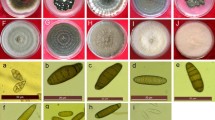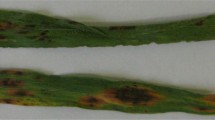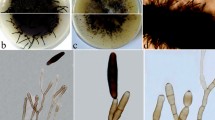Abstract
Causative fungi of net-type and spot-type lesions on barley were isolated and identified as anamorphs of Pyrenophora teres and Pyrenophora japonica respectively. Comparison of morphological characteristics showed that isolates of the two species are separable on the basis of differences in colony texture, conidiophore shape, conidial arrangement and conidial dimensions. The two species could also be distinguished from each other on account of adult-plant reactions exhibited by Dampier barley after inoculation by various isolates from South Africa, one isolate from Germany and one isolate from Washington State in North America.
Similar content being viewed by others
References
McDonald WC. Variability and the inheritance of morphological mutants in Pyrenophora teres. Phyto-pathology 1967; 57: 747–55.
Smedegaard-Peterson V. Pyrenophora teres f. maculata f. nov. and Pyrenophora teres f. teres on barley in Denmark. Yearbook of the Royal Veterinary and Agricultural University (Copenhagen) 1971: 124–44.
Khan TN, Tekauz A. Occurrence and pathogenicity of Drechslern teres isolates causing spot-type symptoms on barley in Western Australia. Plant Dis 1982; 66: 423–25.
Bockelman HE, Sharp EL, Bjarko ME. Isolates of Pyrenophora teres from Montana and the Mediterranean region that produce spot-type lesions on barley. Plant Dis 1983; 67: 696–97.
Smith NJG, Rattray JM. Netblotch, spotblotch and leaf-stripe disease of barley in South Africa. S Afr J Sci 1930; 27: 341–51.
Kenneth R. On the taxonomy, morphology and geographic origins of Pyrenophora teres Drechsler and allied species. Bull Res Counc of Israel 1962; IID: 55–82.
Deadman ML, Cooke BM. A method of spore production for Drechslera teres using detached barley leaves. Trans Brit Myc Soc 1985; 85: 489–93.
Grbavac N. A simple technique for inducing sporulation in Drechslera graminea in culture. Trans Brit Myc Soc 1981; 77: 218–9.
Sivanesan A. Graminicolous species of Bipolaris, Curvularia, Drechslera, Exserohilum and their teleomorphs. Kew (UK): CAB International Mycological Institute, 1987 (Mycological Papers No. 158).
Schoemaker RA. Drechslera Ito. Can J Bot 1962; 40: 809–36.
Schoemaker RA. Atkinson's species of Helminthosporium on grasses from Alabama. Can J Bot 1957; 35: 269–77.
Smedegaard-Petersen V. Inheritance of genetic factors for symptoms and pathogenicity in hybrids of Pyrenophora teres and Pyrenophora graminea. Phytopath Z 1977; 89: 193–202.
Keeling BL, Banttari EE. Factors associated with resistance of barley to Helminthosporium teres. Phytopathology 1975; 65: 464–7.
Khan TN. Relationship between net blotch (Drechslera teres) and losses in grain yield of barley in Western Australia. Aust J Agric Res 1987; 38: 671–9.
Author information
Authors and Affiliations
Rights and permissions
About this article
Cite this article
Scott, D.B. Identity of Pyrenophora isolates causing net-type and spot-type lesions on barley. Mycopathologia 116, 29–35 (1991). https://doi.org/10.1007/BF00436087
Received:
Accepted:
Issue Date:
DOI: https://doi.org/10.1007/BF00436087




